Explore
Interactive Map of the Cathedral
Use the map below to explore the building. Clicking on the points will tell you more detail!
Or download the Useeum App on your mobile for a digital tour
Cathedral Map

Entrance
Entrance to the Cathedral
Narthex
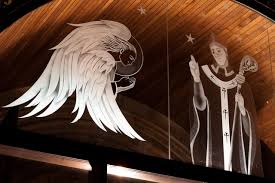
In 2012, this new welcoming entrance was created that transformed the cathedral, flooding it with light and allowing people to glimpse the glorious architecture inside.
The stunning glass porch is called the narthex, a traditional name for the entrance area of the church. The decorative etchings are by glass-engraver, Sally Scott, and depict Saint Wilfrid and his adventurous travels to Rome, one of which ended with a shipwreck and battle off the coast of Sussex (then the kingdom of the South Saxons).
These images of journeying are a reminder that the cathedral has been a place of pilgrimage and has welcomed visitors since its foundation by Saint Wilfrid in 672.
I lift up my eyes to the hill – from where will my help come? My help comes from the Lord, who made heaven and earth … The Lord will keep your going out and coming in from this time on and forevermore. (Psalm 121:1,2,7,8)
The Ripon Story Cushions
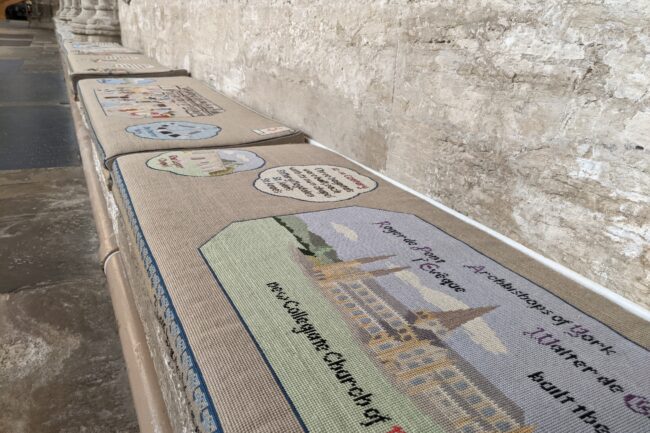
The wonderful Ripon Story cushions were created to celebrate the year 2000. The 38 cushions, which run down either side of the nave (the main body of the church), tell the story of the city of Ripon, from its founding in 672 by St Wilfrid to the present day.
A dedicated group called The Ripon City Stitchers commenced work in October 1999, following months of detailed planning. The designs for the cushions were based on watercolour paintings or sketches by local artist Alan Matthews which were turned into patterns. An embroidery kit was assembled for each cushion which was then assigned to a member of the stitching team who worked on a canvas stretched across a frame.
In all about 90 volunteer stitchers from all over Ripon contributed to the project which took 4 years to complete. Visitors to the cathedral were also invited to add a stitch or two and these included a group of Tibetan Buddhist nuns, a WW II Canadian bomber pilot, who had been stationed near Ripon during the war, as well as a German former prisoner of war who was held in a camp in the area.
After approximately 5 ½ million stitches, the cushions were complete and were dedicated in a service in the cathedral on June 28th, 2003.
The Marble Font
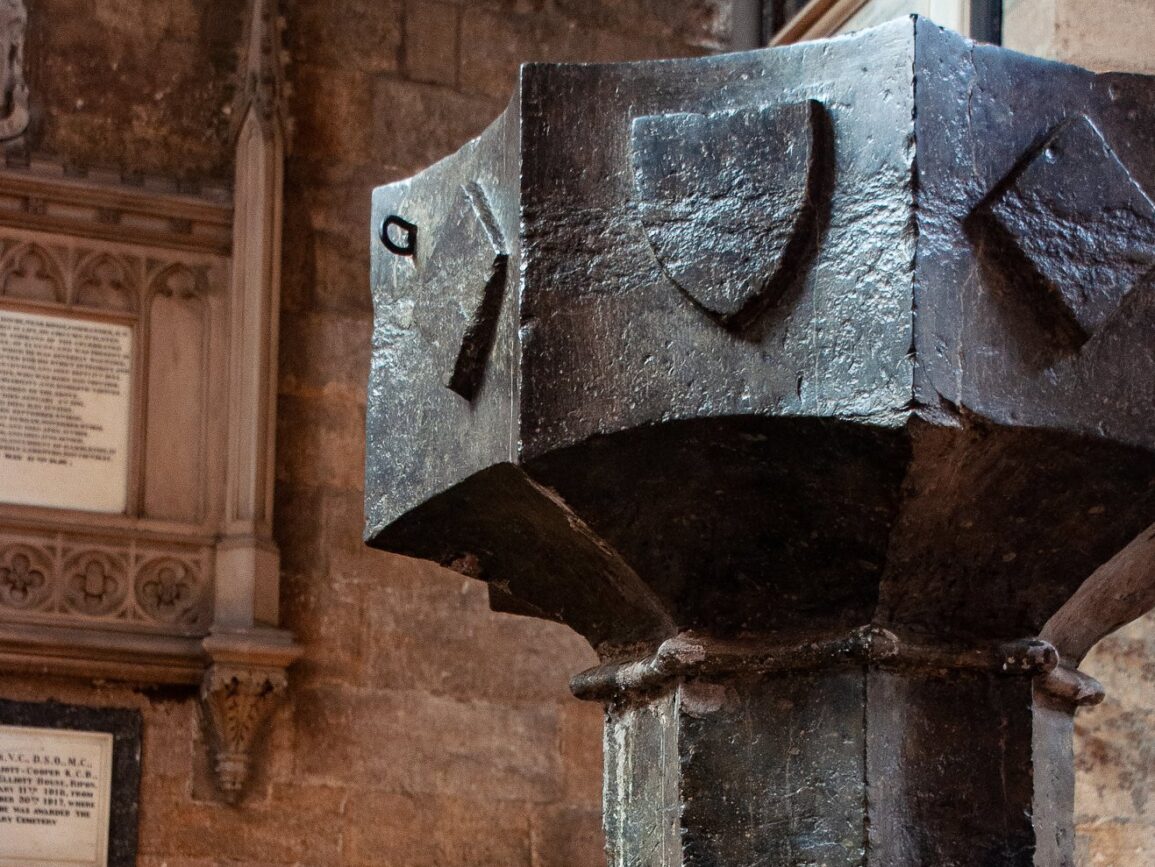
There’s much more to the cathedral’s unassuming font than first meets the eye. It is full of history and hidden spiritual meaning.
The font dates from the late 1400s and is made from ‘Teesdale marble’, quarried at Eggleston, about 40 miles away in County Durham. The sides have been worn smooth, a reminder of the countless baptisms – or christening as it is known for children – that have taken place here over the years.
The font has 8 sides which was an ancient symbolic design telling the story at the heart of the Christian faith. Jesus spent the last turbulent week of his life in Jerusalem where he was buried, following his arrest and execution by the Romans as a militant. On the 8th day, however, his tomb was found to be empty, and Jesus appeared to his friends, transforming death into new life, which became known as Resurrection.
This is why baptism – and the font – are so important for Christians. At baptism, people join God’s family, the church community. The water of baptism, poured over the head, symbolises new life in Christ: not just after death, but in the new beginnings of this life too, through God’s love and forgiveness.
For God so loved the world that he gave his only Son, so that everyone who believes in him may not perish but may have eternal life. (John 3:16)
Pulpit
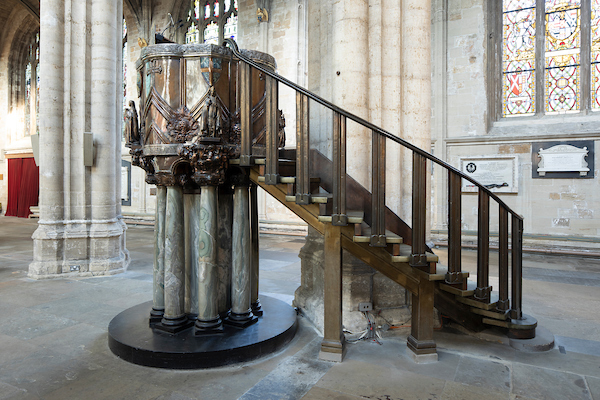
The striking pulpit in the Nave was installed in 1913. Its controversial design was described by its creator as springing ‘like a tiger from its lair’ to claim the attention of the people below, listening to the sermon.
The pulpit was a gift to the cathedral by Canon Howard Stables whose name can be found in the bold zig-zag inscription. Today it is considered a masterpiece of Arts and Crafts design by architect and Metalworker Henry Wilson, although at the time it was not universally popular.
It is made mainly of bronze and marble, with four important Anglo-Saxon Saints depicted on the side: St Cuthbert, St Hilda, St Chad and St Etheldreda. Wilson originally designed a ‘sounding board’ to hang above the pulpit, to help with the voice projection of the speaker. This was adorned with clouds and metal, planet-like spheres but was removed in the 1920s. The current board was added in the 1950s and was apparently created from the top of a table from the Dean’s house.
The Nave

The glorious architecture of the nave helps to create the tranquil and uplifting atmosphere of the cathedral.
The soaring arches and large windows allow light to fall and move through the building, a powerful symbol of God’s presence, in medieval times and still today.
This grand architecture dates from the late 15th / early 16th centuries, as much of the nave was rebuilt when the partial collapse of the central tower in 1450 revealed the poor state of the original 12th century building. However, you can still see remains of the earlier nave, with smaller arches and windows, in the wall above the cathedral shop.
Anglo-Saxon Crypt

Ripon cathedral’s remarkable crypt is the oldest part of any cathedral in England. This small chapel, hidden underground, was a key feature of the first church built here by Saint Wilfrid in 672.
Saint Wilfrid’s design for the church in Ripon was inspired by his travels across the continent to Rome where he saw magnificent churches with ‘catacombs’ below, elaborate underground burial chambers.
Wilfrid brought stonemasons and craftsmen from overseas to help build the impressive church here, with its columns and side aisles, at a time when most buildings were made of wood. The crypt was one of the most important and sacred spaces in the church as it held holy relics. These were precious items linked to saints, like Saint Peter – one of Jesus’ closest friends – to whom Wilfrid dedicated the church at Ripon.
The crypt was designed so that it would be a powerful experience for pilgrims and help to strengthen their faith. The passageways and central chamber would be lit by candlelight which would light up the luxurious wall decorations in gold, silver and purple. The pilgrim would go underground, to the place of burial, and then up into the awe-inspiring church above, a journey which symbolised Jesus’ death and the hope of his Resurrection.
It is amazing to think that the Crypt is still a place of prayer, pilgrimage and inspiration some 1350 years after Wilfrid first laid the foundations of faith in this place.
O almighty God, who caused you dear Son, our Saviour Christ, to assume human form and submit to being hanged on the cross, grant that we may benefit from the example of His endurance and participate in his true resurrection. Amen.
Gosney Statues
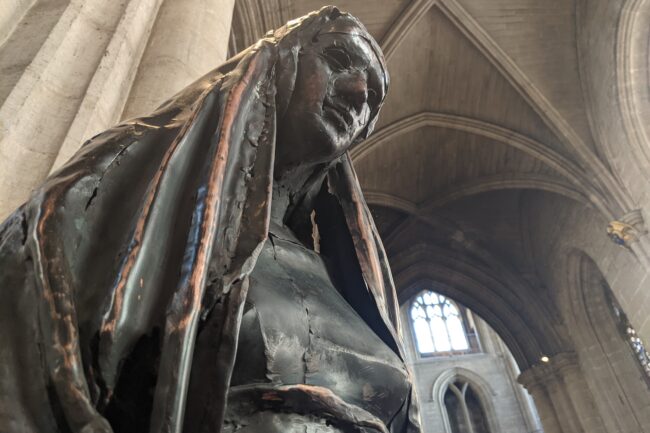
Art plays an important role in Christian spirituality; to illuminate, comfort and inspire people with the stories and beliefs at the heart of the Christian faith.
You can see exceptional artwork in Ripon cathedral, spanning over a thousand years, from the cathedral’s foundation in the 7th century to the present day.
Some of the most striking of the modern artwork are the three copper statues by sculptor Harold Gosney. These were installed in the 1990s with prayer points around the cathedral where you can light a candle.
The three statues show Mary holding her son Jesus at different point in his life: as a baby, as a playful toddler, and - heartbreakingly – Mary cradling Jesus’ dead body after his crucifixion (a traditional image in Christian art known as a Pieta).
Medieval Screen
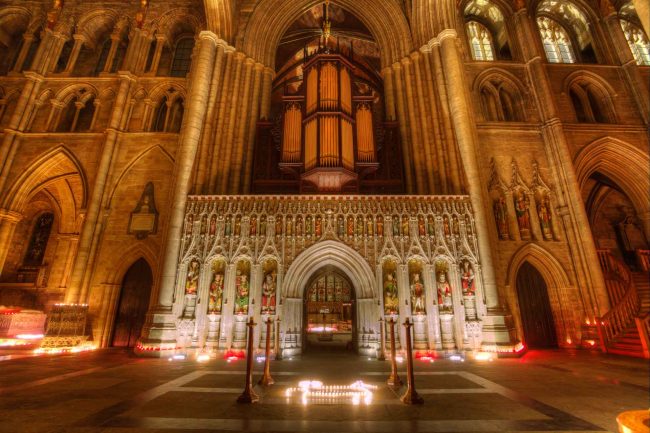
This magnificent ornate stone screen (known as a pulpitum) was created around 1480 but the impressive statues were a 20th century modern restoration, giving us a window on to the colourful medieval church.
The statues were commissioned by the Friends of Ripon Cathedral and designed by sculptor Esmond Burton. In 1947, the then Princess Royal visited the cathedral to unveil the 32 figures, but the vibrant colour was only added over a decade later, in 1958. The medieval church would have been a riot of colour and these statues give us a glimpse of what that might have looked like.
The pulpitum was designed to separate two parts of the church and create a sense of mystery and drama. The main body of the church, called the nave, was the area for public worship, visitors and pilgrims. The impressive stone screen allowed glimpses of the sacred spaces beyond but the quire and sanctuary were strictly reserved for the choir and priests. The clergy could stand on top of the pulpitum to address the public below – hence the name pulpitum – but today you will just find the cathedral organ (and organist) up there!
Look closely and you can still see some of the intricate medieval carvings on the pulpitum, while the modern sculptures depict Saints and Kings with important connections to the cathedral.
Scroll down (or click here) to see the connections with the royals that we have had over the years.
St Wilfred's Chapel & Markenfield Tombs
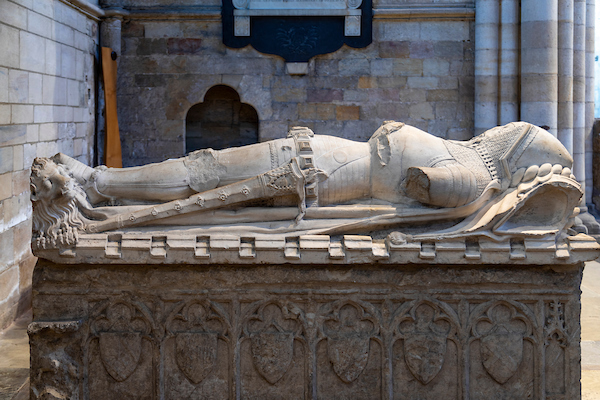
Saint Wilfrid is the Patron Saint of Ripon. He built the first magnificent church here in 672 which became an important place of pilgrimage. The city still celebrates its founder in an annual St Wilfrid’s day procession and festival.
The window in the St Wilfrid’s Chapel illustrates events from his colourful life. Wilfrid was born around 634 in the Kingdom of Northumbria into an aristocratic family. At 14 he was sent by the Queen to be educated at the monastery on the island of Lindisfarne. A few years later he set out on the first of his three adventurous trips to Rome where he was impressed by the glorious church buildings and their monastic communities.
On his return to Northumbria, Wilfrid was made Abbott of Ripon and began to build a breath-taking church here whose crypt still stands some 1350 years later. Although Wilfrid travelled widely, lived and built churches in other kingdoms, the church at Ripon remained his spiritual home.
Wilfrid’s passion was to lay strong foundations of the Christian church in the Pagan Anglo-Saxon kingdoms, and he became one of the most influential and pioneering leaders. But his life was turbulent. His bravery, loyalty and straight-talking led him to face execution, battles and prison when he was younger. However, he also provoked conflict and made enemies through his driven personality and confident, uncompromising self-belief.
After he died, in 709 he was buried here and it is thought his shrine would have been at the top of the church where the high altar is today. A year after his death, a moonbow appeared above Ripon, just as the monks finished evening prayer; a sign, they believed, that through Wilfrid God was blessing this special place.
The two tombs here belong to members of one of the great historic Ripon families, the Markenfields. Their 14th century moated manor house, three miles south from here, is still lived in. The two people remembered here with their wives were both called Sir Thomas Markenfield.
Mother's Union Chapel
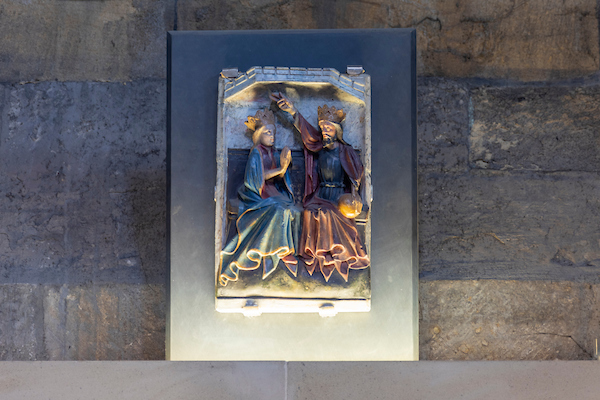
The Mother's Union Chapel, to the left of Saint Wilfrid's Chapel, is dedicated to the Christians throughout the Diocese of Leeds who help support families and fight injustice.
As well as offering support for prisoners, those with dementia and the poor, along with their families, the Mother's Union upholds women's rights and fights for refuges from domestic violence.
We invite young families to use this chapel, and ponder what more could be done to support those in need.
Quire and Misercords
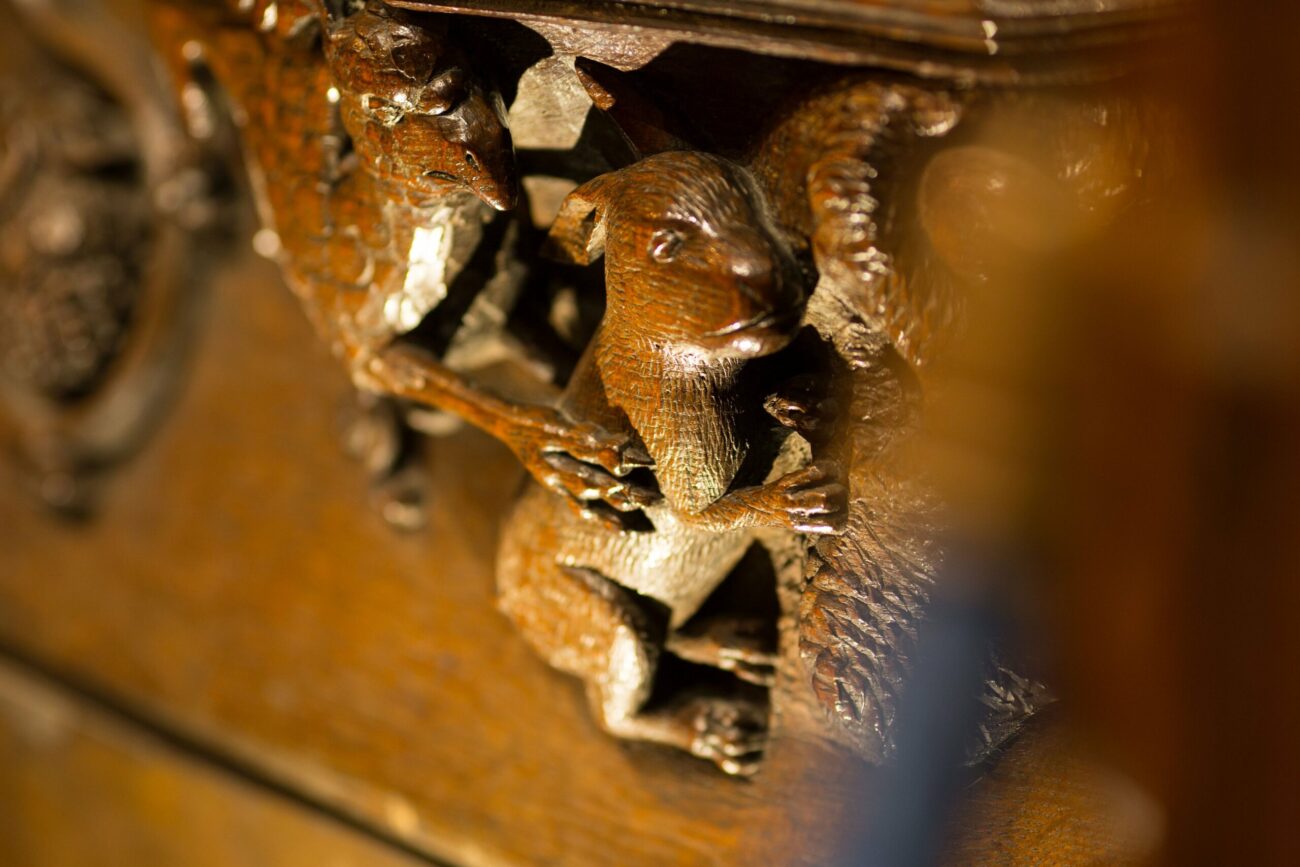
The superb wooden carvings in the quire are one of the cathedral’s hidden treasures. Their most celebrated claim to fame is that the carvings on the choir seats (known as misericords) inspired some of the characters in Alice in Wonderland.
Lewis Carroll, the author, spent time as a boy in Ripon when his father was a canon of the cathedral, and we can imagine his fascination with the weird and wonderful images on the underside of the choir stalls. One seat shows a rabbit scuttling down a rabbit hole, and another has curious beings with their faces on their chests. When Lewis Carroll drew a picture of Alice when she shrank, she looked just like one of these odd creations.
The quire is the part of the cathedral where morning and evening prayer take place, as well as uplifting Choral Evensong, as it has done for centuries. In medieval times, this special area was only for the clergy and the choir, and the beautiful choir stalls were created for them between 1489 and 1494. However, people were expected to stand during most of the lengthy acts of worship and so seats were designed to discretely offer a bit of help. The seats would be kept flipped up, like cinema seats, with the top edge offering a ledge to perch or lean on. This is why they became known as misericords, mercy seats, from the Latin ‘misericordia’ – pity or mercy.
One of the most eye-catching wooden carvings is the mysterious hand above the entrance to the quire. This ingenious mechanical hand, which still works, was installed in 1695 so that the organist could also conduct the choir.
St Peter's Chapel
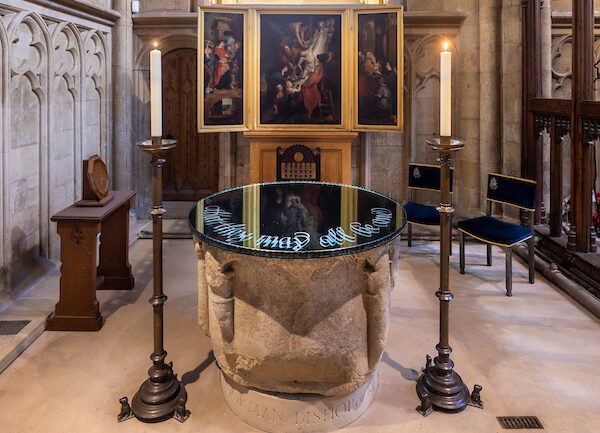
To the left of the high altar is the small St Peter’s chapel. The intriguing altar is made from a medieval stone font with a beautiful glass top, added in 1998.
Behind is a copy of a painting by Rubens showing events from Jesus’ life.
Ripon Cathedral was founded by Saint Wilfrid in 672 and was dedicated to Saint Peter. Peter was one of Jesus’ closest friends and loyal followers, and is traditionally thought to have been the first Bishop of Rome. It is possible that Wilfrid brought back relics linked to Saint Peter from Rome for his church here in Ripon.
The High Altar and the Great East Window
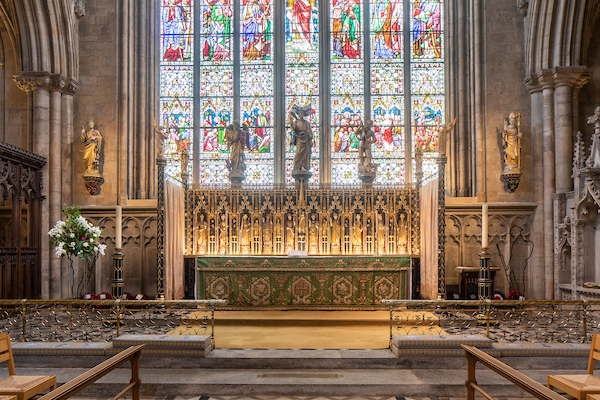
The Great East Window soars above the High Altar with its poignant golden backdrop, creating the visual focal point of the cathedral and its spiritual centrepiece.
The great east window, with its intricate stonework, dates from around 1300 and is 16 metres high. The original medieval glass was lost through much damage to the window over the centuries and the colourful glass you see today was installed in 1854 and 1896.
From the early days of the Christian faith, churches were built to point east, and the rising sun, flooding the cathedral with light through the great east window, is still a daily symbol of hope and Resurrection.
The high altar beneath is used for the celebration of the Eucharist, Holy Communion. In this service, bread and wine are shared as the story of Jesus’ last supper is retold, with his teachings about love, sacrifice, forgiveness and hope.
The gilded backdrop to the high altar (the reredos – ‘the screen behind’) was created in 1922 by Sir Ninian Comper, an important Scottish architect who restored medieval grandeur to aspects of many churches and cathedrals. The reredos was designed as a memorial to the fallen of WW I, whose names are recorded on either side of the screen. The central figure above the screen represents the risen Christ but he is shown without a beard - a moving reminder of the youth of those who were killed.
Let your light so shine before men that they may see your good works, and glorify your Father who is in heaven (Matthew 5:16).
Chapel of the Holy Spirit
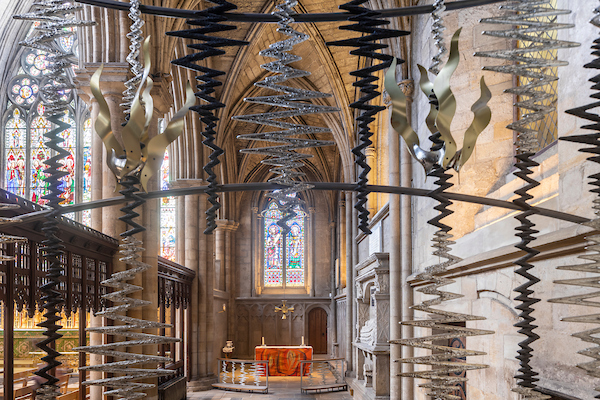
Three pieces of striking gold sculpture, created in 1970 by one of the UK’s best-known silversmiths, symbolise God as Holy Spirit, in the small side chapel to the right of the high altar.
The most immediately eye-catching is a three-dimensional golden cross, suspended mid-air above the altar, inspired by space technology. It represents God’s Spirit in Jesus. The cross is in fact a pyx – a box where special blessed bread (in the form of a wafer), is kept for use in the service of Holy Communion. Jesus asked his followers to share bread and wine to remember the love, forgiveness and hope he spoke about and revealed in his death and Resurrection.
Above the pyx is God’s Spirit in Creation symbolised in a beautifully simple model of an atom. At the entrance to the chapel is a screen decorated with flames and flashes of lightening. This shows the dramatic events celebrated at the festival of Pentecost, when God’s Spirit inspired the first Christians to risk persecution and death to share the good news about Jesus.
The sculptor Leslie Durbin (1913-2005) was one of England’s leading designers in silver. Two of his most famous achievements are the ‘Sword of Stalingrad’ and designs for the £1 coin in the 1980s. Durbin worked on a bejewelled ceremonial sword, commissioned by King George VI. On 29th November 1943, it was presented to Joseph Stalin by Winston Churchill to commemorate the resistance of the Soviet people during the horrendous Battle of Stalingrad. Later in his professional life, Durbin created designs for the £1 coins to represent the four nations of the UK.
Library
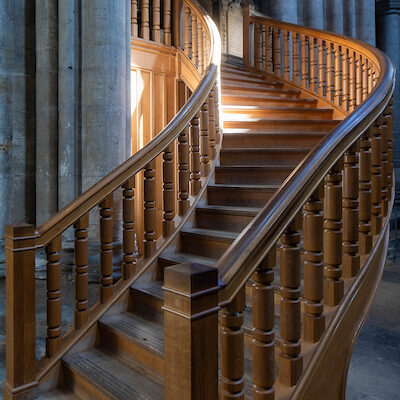
The library was built in the early 1300s as a ‘lady’ chapel which means it was dedicated to Mary, Jesus’ mother.
It was converted into a library in 1624 as the use of lady chapels had fallen out of use after the Reformation.
The library was created to house the valuable books of a former Dean of the cathedral, Anthony Higgin, and many of them are now kept in the Brotherton Library of the University of Leeds. There is a statue to Anthony Higgin in the library and you can read more about him on our Heritage Blog here
Today in the library you can see the stunning Anglo-Saxon Ripon Jewel, alongside the cathedral’s historic treasury (a beautiful collection of ornate gold and silver items used for the celebration of Holy Communion).
The Ripon Jewel is a small circular gold ornament, inlaid with amber and garnet. It is thought to date from the mid-7th century, from time when Saint Wilfrid was appointed Abbott of Ripon and began to build the first magnificent stone church here. It could have been a small decoration from the church, perhaps adorning a book or casket, but it might also have been worn by someone of high rank.
Chapter House
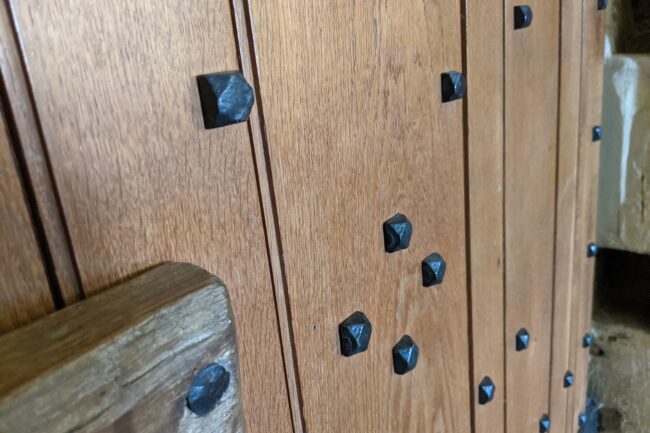
The Chapter House is the operational hub of the cathedral - the location of our Vergers.
Built in the late 12th Century, this is where the clergy dress in holy vestments before services. Historically, this would have been where monks would take vows and important guests be received.
The Chapter House is kept secure and is generally closed to the public. Ring 01765 602072 or knock on the door for access.
Royals of Ripon Cathedral
Explore the links to royalty we have had throughout the years
Royals Map
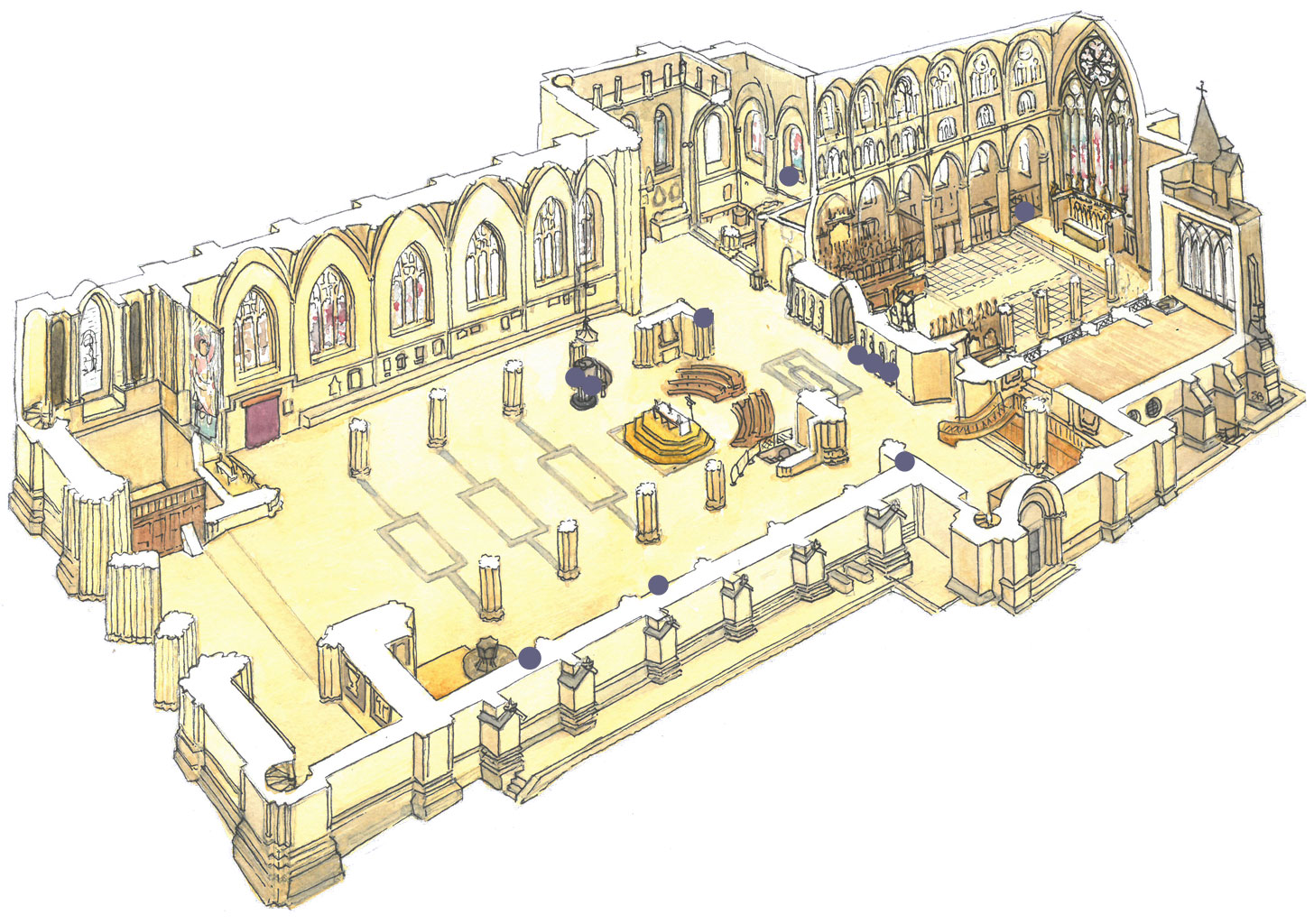
Edward II
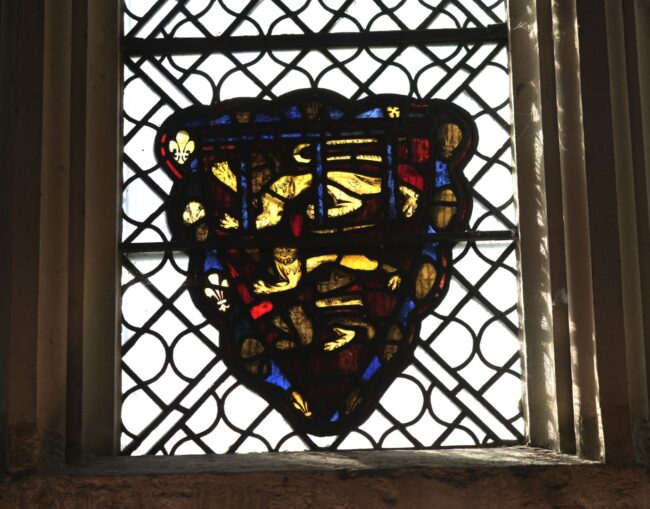
Edward II's coat of arms can be seen here in the medieval stained glass. Nearly all the glass in the cathedral was damaged during the Reformation and Civil War so very little remains. This window has been restored using fragments of recovered medieval glass.
Edward II also called for Parliament to sit in Ripon in 1322 to avoid plague in London, but in the end York was chosen instead.
b.1284 - d.1387
Photo Judith Hooper
Charles I
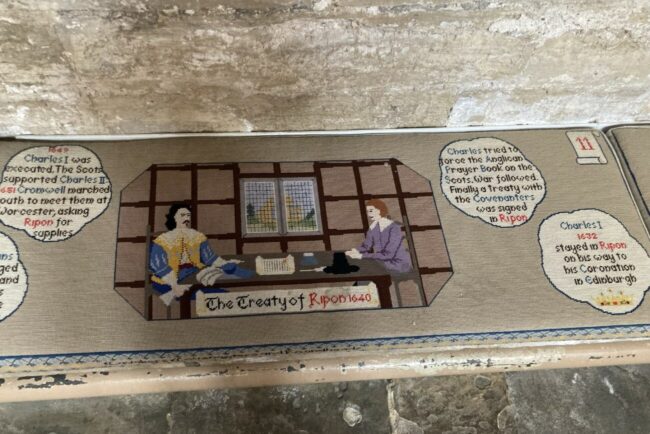
Charles I came to Ripon Cathedral (then a minster) to sign a treaty with the Scots in 1640. He would have been entertained in the minster and in a minister's house.
He was also brought here as a prisoner in 1646 after the English Civil War.
b. 1600 - ex. 1649
Etheldreda
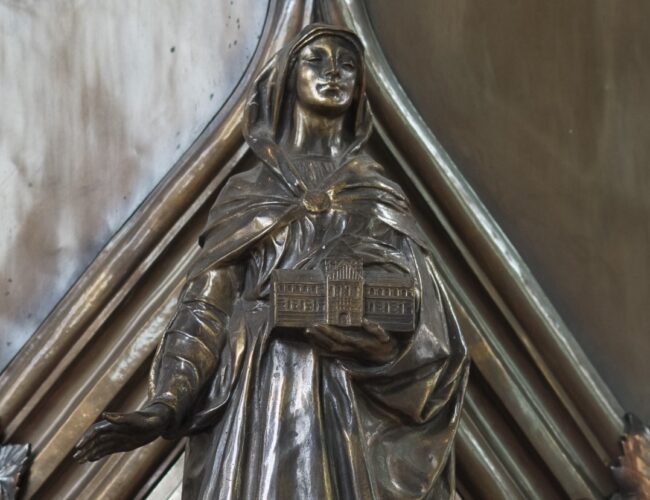
Etheldreda was a daughter of King Anna of East Anglia. She married twice, her second husband being King Ecgfrith of Northumbria. He was only fifteen when they wed.
Throughout both marriages she remained a virgin as chastity was thought to be true devotion to Christianity. Originally Ecgfrith agreed with this but some years later he is said to have wanted a normal marital relationship.
Etheldreda went to Wilfrid, her spiritual adviser, and with his counsel, she refused her husband, left her marriage and became a nun.
Eltheldreda founded Ely Abbey, a double monastery for monks and nuns in 673. Ely Cathedral now sits on the same site.
Hild
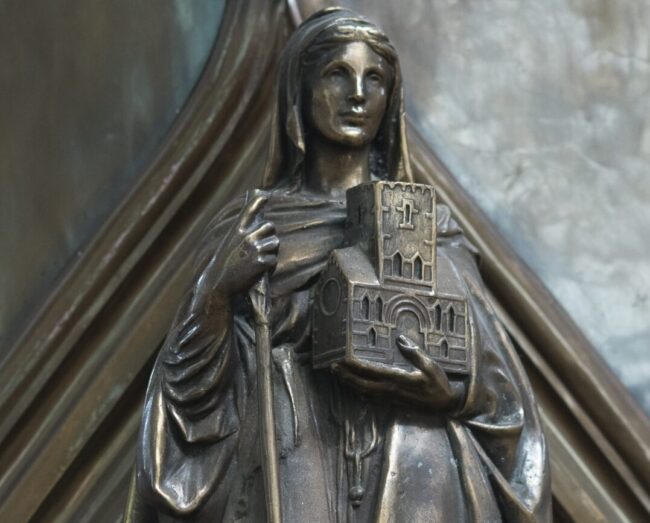
Hild was Abbess of Whitby, a powerful religious centre in the Anglo-Saxon world.
She was the great niece of the Northumbrian king Edwin, and she was raised in his court after her father was murdered.
Hild hosted the Synod of Whitby in 664, which Wilfrid attended as Bishop of Northumbria. Northumbria was still following mainly Celtic traditions, even though the rest of the western Church had adopted the Roman style. The Synod of Whitby was called to sort out whether Northumbria should calculate the date of Easter by the Celtic or Roman method.
Hild appeared to favour the Celtic way, whereas Wilfrid proposed adopting the Roman method. At the Synod in 664, King Oswiu of Northumbria ruled in favour of Wilfrid and Roman tradition.
Legend has it that Whitby was plagued by snakes, and Hild prayed to God that their heads be removed and they be turned into stone. Hild's carving on the pulpit has a shield with three snakes to represent this.
b. 614 – d. 680
James I
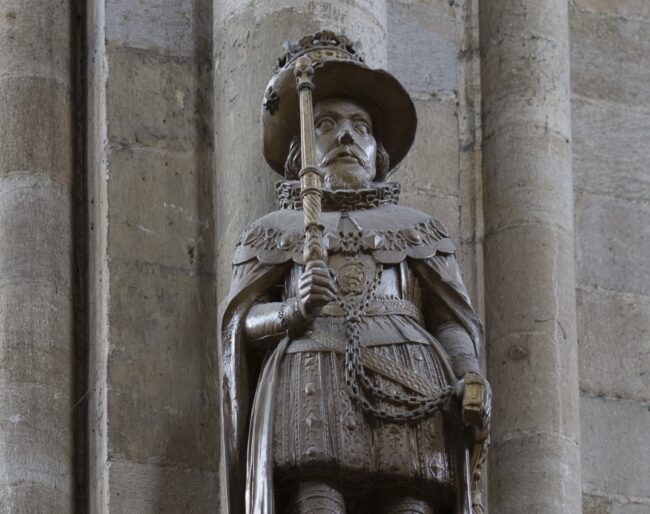
This statue shows beautifully the costume of the early Stuart period. It is contemporary, created in about 1620 for York Minster.
This James I was in York Minster until 1810 when it was removed to make way for a new King Henry VI statue. James I was donated to Ripon Cathedral by the Dean and Chapter of York at this time.
Photo Judith Hooper
Royal coat of arms
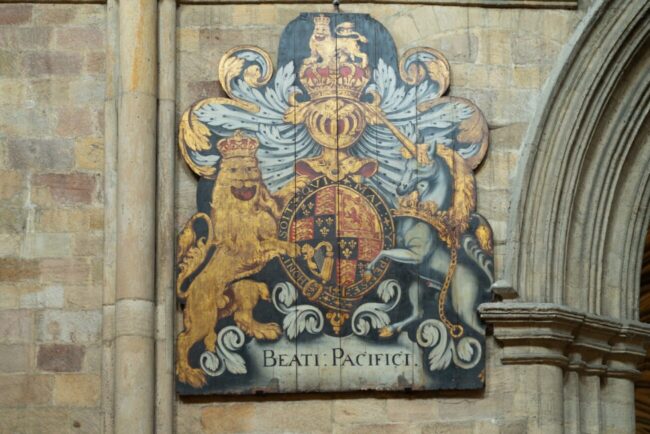
This is the Royal Coat of Arms belonging to James I. All parish churches had one of these, but few also contained any writing. The inscription underneath translates as "Blessed are the Peacemakers". Unusually, this coat of arms is also double sided.
Can you find reference to James I anywhere else?
Jubilee Chairs
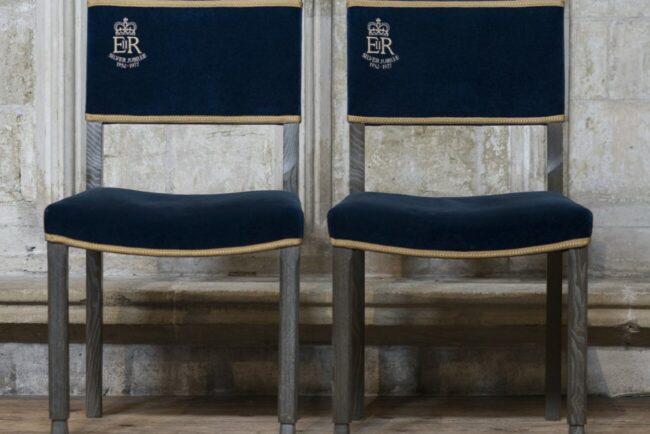
These chairs, now set in the sanctuary of St Peter's Chapel, were to commemorate the Silver Jubilee of Queen Elizabeth II in 1977.
They have been used by royalty when the Queen came to Ripon Cathedral for the Maundy service and to distribute Maundy money in 1985.
Now, they are primarily used in weddings for the bridal couple to sit in after the signing of the register.
Photo Judith Hooper
Eanfled
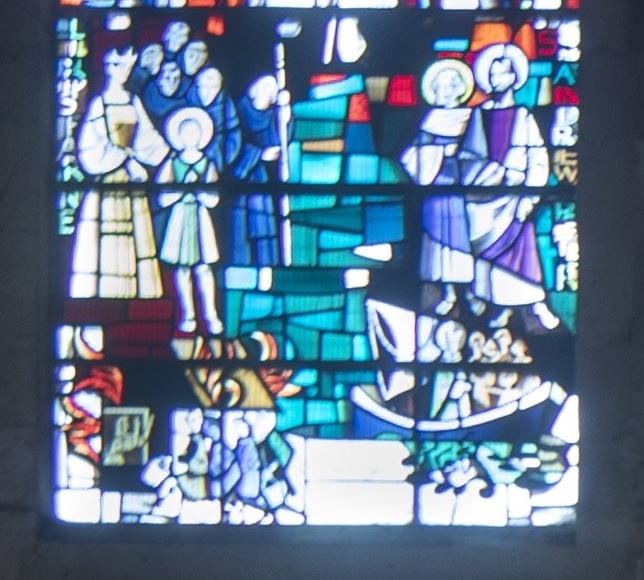
Queen Eanfled was a Saxon queen married to King Oswig of Northumbria.
She was instrumental in Wilfrid getting an education as a boy and she helped him with his first trip to Rome. Wilfrid visited Rome and Europe several times and these trips inspired him to create the crypt here at Ripon.
Eanfled was a close advisor to Wilfrid throughout her married life. After her husband King Oswig died in 670 AD Eanfled retired to Whitby Abbey and ultimately became abbess there with her daughter.
Eanfled is portrayed in the bottom left corner of the window in St Wilfrid's chapel.
b. 626 - d. 704
Athelstan
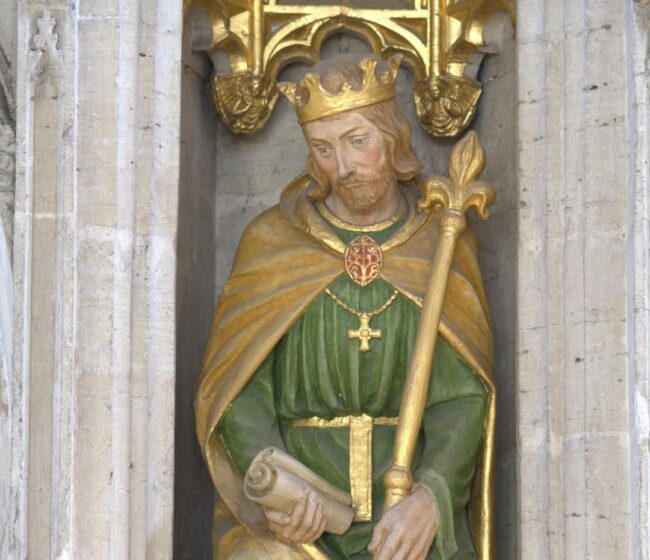
Athelstan or Aethelstan is generally regarded as the first King of England.
He established a treaty with the then king of York, Sihtric in 926, and when Sihtric died the following year, a few more battles (not in York) led to the completion of the reconquest. Athelstan, however, claimed it to be from the moment when peace was established in 926.
In 926 Athelstan also established the Liberty of St Wilfrid: an area of one mile radius around the minster at Ripon that offered shelter to all and was outside royal authority.
b.894 – d.939 AD
Photo Judith Hooper
Henry II
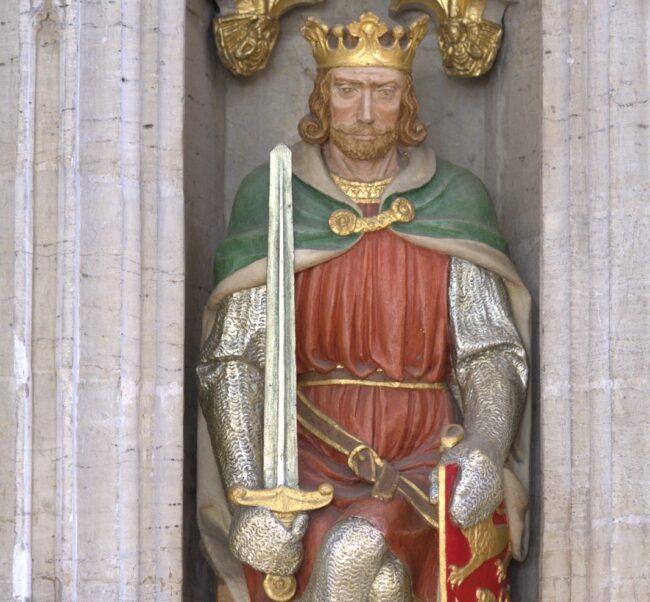
Henry II was the monarch at the time of the Archbishop of York Roger de Pont l'Évêque.
Roger rebuilt much of Ripon Cathedral after the "Harrying of the North" by William the Conqueror a hundred years before. The current Chapter House, Library and the transepts were all built by Roger around 1180.
Henry II asked Roger to crown his son in 1170 because of a dispute between Henry II and Thomas Beckett, the Archbishop of Canterbury. Thomas excommunicated Roger for this and Roger is implicated in Thomas's murder shortly after, supposedly at the wishes of Henry II.
b.1133 – d.1189
Photo Judith Hooper
James I
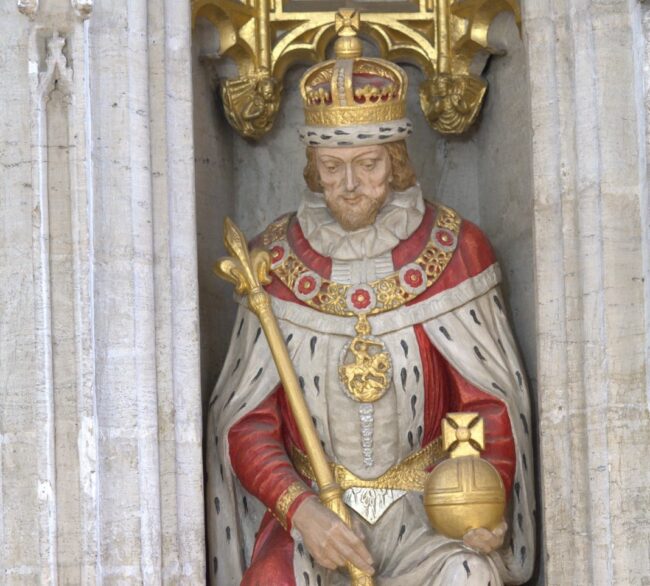
James I was the successor to Elizabeth I and the first King of England and Scotland.
In 1604 James I granted a charter to Ripon for worship. His charter created a "collegiate church" consisting of a Dean and six canons, six lay clerks (adults) and six choristers (children).
James I also granted a second charter to Ripon which created the Mayor and allowed for independent local governing.
b.1566 — d.1625
Photo Judith Hooper
View PDF trail below
Virtual Crypt Tour
Go down into our Saxon crypt built by Wilfrid in 672 AD
Virtual Library Tour
Take a look at some of the fascinating artefacts in the cathedral’s library


This page is licensed under a Creative Commons Attribution 4.0 International License.